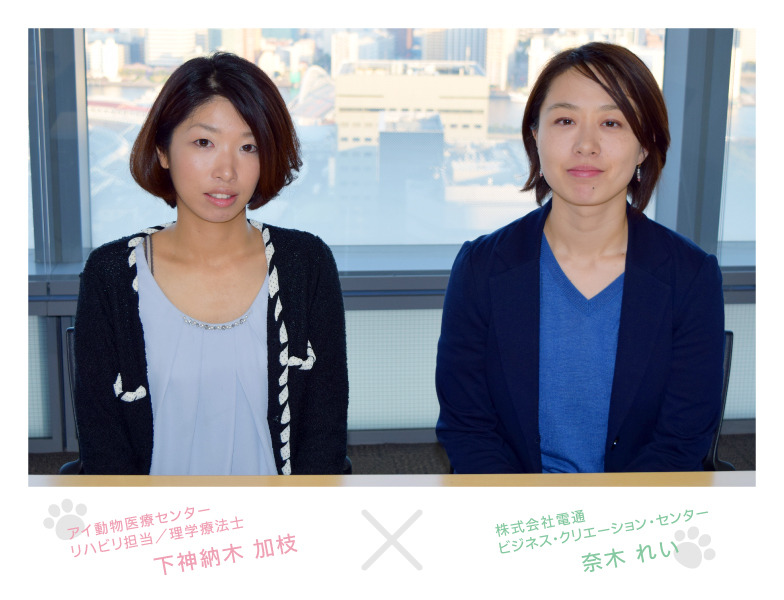The average lifespan of pets is said to have increased dramatically over the past decade or so due to changes in breeding environments and the advancement of pet food. While this means more time can be spent with beloved pets, it also brings various problems associated with aging, much like humans.
Amidst this, physical therapy for pets is gaining attention in Japan. To explore the potential of physical therapy in building a better society for humans and pets, we spoke with Ms. Kagee Shimokami, a physical therapist specializing in animal rehabilitation, and Ms. Rei Nagi, a member of the Think Pet Project.
From Human Physical Therapist to Pet Physical Therapist
Nagi: Through various research conducted by Think Pet Project, I consistently feel that the aging of pets is an issue we must confront.
While various care services are gradually emerging, physical therapy remains largely unknown in Japan. What specific work do you do?
Shimokamigaki: Fundamentally, it's the same as human rehabilitation. We focus on exercises to maintain physical strength and balance function. Also, dogs can develop cognitive dysfunction.
Nagi: Like wandering around at night or barking at nothing, right?
Shimokamigaki: When dogs get older and spend most of the day indoors, their dementia tends to progress rapidly. Physical therapy can intervene by providing external stimulation.
Nagi: But you're not actually an animal physical therapist, are you, Shimo-Kaminoki-san?
Shimokamigaki: That's correct. I hold a national license as a human physical therapist, so my original specialty is human rehabilitation.
Nagi: What led you to pursue the path of animal physical therapy?
Shimokamiki: It started when I happened to come across some foreign literature on animal physical therapy while attending physical therapy school.
I've loved animals since I was little, so I thought it would be great to work with animals in the field of physical therapy. When I looked into it, I found out that a physical therapy seminar for Japanese veterinarians was being held in Australia. I'm not a veterinarian, but I was allowed to participate.
Nagi: Is it common for human physical therapists to become animal physical therapists?
Shimokamiki: As far as I know, there are only about five or six people in Japan.
Animal-specific physical therapy is still a very new and developing field in Japan. When I asked instructors at training schools, they told me, "There's no such profession in Japan."
Nagi: I see. Do they exist overseas?
Shimokamigaki: Yes, there is a qualification for animal physical therapists. Many people first obtain a physical therapist qualification at a four-year university, then pursue a graduate degree to become an animal physical therapist.
Alternatively, some universities have animal physical therapy education systems with both veterinary and physical therapy programs. Students complete coursework, practical training, and internships there to obtain their license.
Outside Australia, I've heard that countries like the US, UK, and Nordic nations like Sweden and Finland are also quite advanced in animal physical therapy.
Nagi: Why is it that while it's recognized as a specialized field overseas, it hasn't penetrated Japan to the same extent?
Shimokamigaki: Fundamentally, when studying human physical therapy, information about the animal field is completely absent. Overseas, veterinary associations and human physical therapy societies collaborate to operate organizations like the Animal Physical Therapy Society. In Japan, however, there are almost no places where veterinarians and physical therapists interact, which I believe is a major factor hindering its development.
To Avoid Elderly Caring for Elderly
Nagi: By the way, human physical therapy and pet physical therapy are quite different, right?
Shimokamigaki: The biggest difference is bipedal vs. quadrupedal movement.
Since anatomy and kinesiology are crucial in physical therapy, we study each muscle individually to understand which ones act on specific movements in animals. Also, while humans can verbally communicate which areas they want moved, that's difficult with animals.
Nagi: Doesn't it also vary by breed?
Shimokami Nagi: Yes. Their leg lengths differ, so you learn through experience. Breeds also have different predispositions to certain diseases.
For example, Shiba Inus are prone to glaucoma, Dachshunds to intervertebral disc herniation, and Chihuahuas to hydrocephalus.
Nagi: I've heard Golden Retrievers are prone to skin cancer. My old Golden Retriever had skin cancer and gradually lost the ability to walk.
Back then, there were virtually no specialized care products for pets, and caring for a large dog weighing nearly 40 kilograms was incredibly difficult. For elderly pet owners, the issue of elderly-to-elderly care is a real concern.
Shimokamigaki: Pets mean a lot to seniors living alone and feeling lonely. From the perspective of preventing dementia, it's wonderful for seniors to have pets.
But the reality is, there are far too few care services and safety nets available after you actually get a pet.
Nagi: That's a real challenge. Cats are creatures that tend to bond more with their home than with people, so services leveraging that trait are increasing. But dogs are creatures whose relationship with people is absolutely essential.
In fact, while the number of dogs kept as pets is declining compared to cats, we at the Think Pet Project want to explore how we can make it easier for people to keep dogs.
Shimokamigaki: Yes, I agree. I believe the field of physical therapy also has potential to contribute here.
※Part 2 is scheduled for release on Wednesday, May 27.










